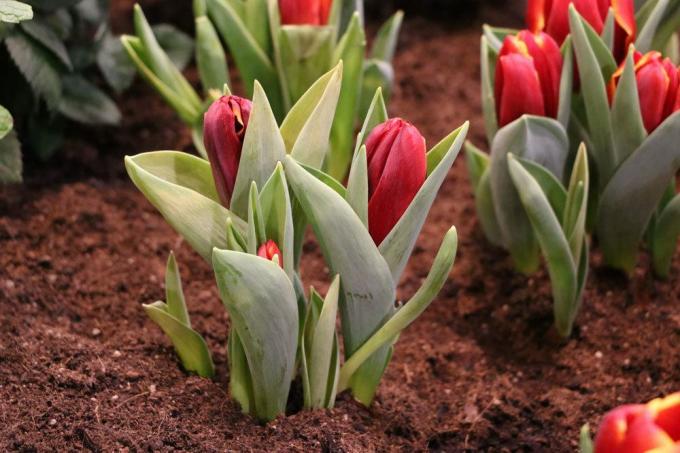
table of contents
- Grave planting in spring
- Bulb plants as grave plants
- Plants from H - K
- Plants from M - N
- Plants from S - T
- Grave planting in spring through annual seasonal planting
- Plants with G
- Plants from R - S
- Plants with V
The subject of grave planting is one of the most sensitive areas for hobby gardeners and professionals alike. Because the plants chosen should put the grave in the right light, be easy to care for and at the same time appear appropriate to the environment of a cemetery. With our suggestions you will also find suitable plants for grave planting and their surroundings in spring.
Grave planting in spring
Note: Do not be surprised if numerous plants from completely different areas look familiar to you. Because why should graves always be dreary and inconspicuous? The commemoration of the buried people can be expressed in the spring, typical of the season, with brightly colored, colorful plants in the grave planting.
Bulb plants as grave plants
Bulb plants are put into the ground as early as autumn. There is therefore no need for time-consuming planting in the ground that has just frozen. In addition, they usually last for several years, which significantly reduces the effort. Once inserted, they are well suited, for example, as self-appearing gaps in other plantings, as well as independent decoration of graves that are less frequently cared for. They are also among the first plants to break through the soil in spring and start growing. The reason for this is the energy reservoir present in the onion.
Plants from H - K
Hyacinth (hyacinthus)
In contrast to most other early bloomers, the hyacinth is convincing with multi-flowered grapes. Since the flowers emit a characteristic, strongly sweet odor, these plants enrich a grave in several ways. The fact that they are several years old means little effort, as there is no need to replant them in the following year.
- Appearance: narrow, strip-like, shiny leaves, short racemose inflorescence with short, stalked flowers, 6 equal petals, approx. two thirds are fused with tubes, the flowers are purple to blue in color
- Size: 15 to 40 centimeters
- Flowering period: March to May
- Other: an onion plant belonging to the asparagus family with a penetrating, sweet odor of flowers

crocus (Crocus)
More colorful than the snowdrop, the crocus is able to enrich the green and white of the first simultaneous plants with intense colors. Because of its small size, the crocus is particularly impressive when it occurs in large numbers through the formation of carpets of flowers.
- Appearance: mostly six basal leaves with a smooth margin and a whitish central nerve, narrow, tapering ones Petals standing in two circles, form upright, upward-pointing flowers, flower color white, yellow, blue to purple
- Size: 8 to 15 centimeters
- Flowering period: February to March
- Other: in addition to early blooming species, there are also autumn blooming species, often confused with autumn crocus

Plants from M - N
Märzenbecher (Leucojum Vernum)
Not unlike the snowdrop, but appearing much later, is the Märzenbecher. It clearly resembles the snowdrop and is therefore very suitable as an alternative that is created by the Later flowering can be easily arranged together with other flowering plants as grave plants in spring is.
- Appearance: similar to the snowdrop with basal, slender leaves and a towering, thin stem. Hanging, white flower with a bell-shaped calyx per stem, 6 white, uniform stamens per flower
- Size: around 10 to 30 centimeters
- Flowering period: March to April
- Other: Also known as the spring knot flower, distantly related to the snowdrop
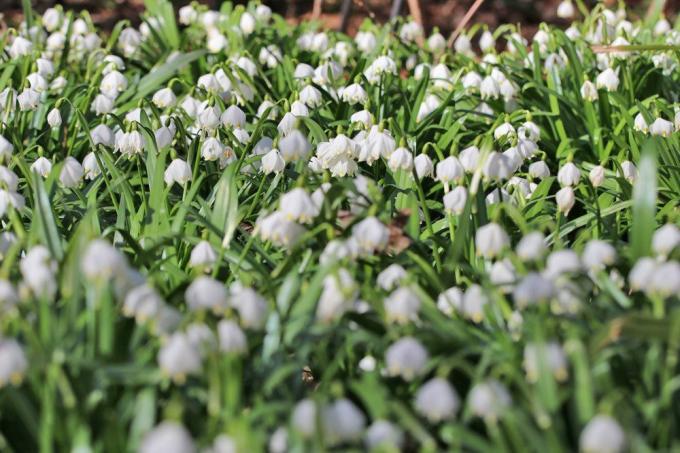
Daffodil (Narcissus)
Often referred to as the daffodil, the daffodil is one of the heralds of spring. The distinctive, usually yellow flowers are a distinctive unique selling point, so that Daffodils present a grave imposingly and at the same time discreetly, even without additional accompanying plants can.
- Appearance: usually three to four linear to strap-shaped leaves, leafless inflorescence stems, upright with one single one each Blossom, blossom open, often in the characteristic shape of a flat plate with a raised crown, colors yellow, more rarely white or orange
- Size: heights between 5 and 80 centimeters
- Flowering period: March and April, rarely until May
- Other: Onions from the third year of growth with traction roots, which pull the onion deeper into the ground over the growth period, thus increasing winter hardiness of the onions
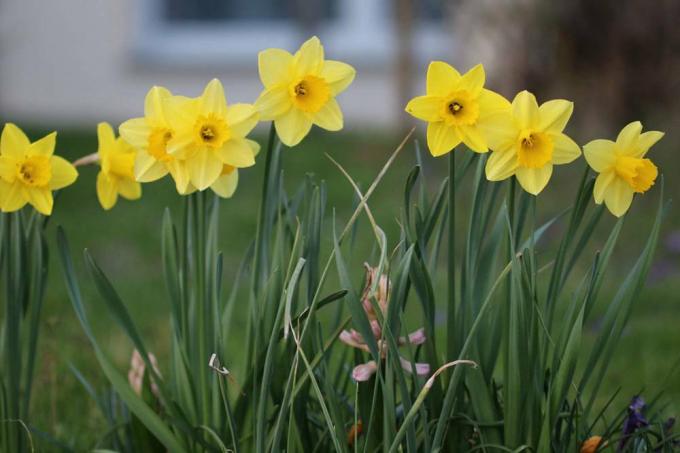
Plants from S - T
Checkerboard flower, too Chess flower (Fritillaria meleagris)
The most captivating feature of the checkerboard flower, the eponymous drawing of the petals, is usually only recognizable at second glance. This spring-like plant can be seen as an invitation to pause at the grave of loved ones and reflect on the details of nature.
- Appearance: bare, straight stem with alternate, delicate leaves, usually four to six gray-green, very narrow leaves, one, more rarely two nodding to drooping flowers made up of six petals, these with characteristic, checkerboard-like markings, colors white to purple
- Size: 15 to 20 centimeters in height
- Flowering period: April to May
- Other: perennial bulb plant, drawing of the flowers is still faintly recognizable even in the white variant

S.snowdrop (Galanthus)
They usually break through the earth as the first signs of spring and announce the approaching spring. Snowdrops are therefore ideal for the transition from wintry dreariness to the subsequent plants. At the same time, their reserved appearance offers an optimal entry into the re-awakening life of the new growth period.
- Appearance: basal, narrow foliage leaves, long, straight style with hanging, white single flowers, these with three white bracts and three overgrown, white-greenish inner leaves
- Size: 7 to 15 centimeters
- Flowering period: February to March
- Other: belongs to the amaryllis family, a total of approx. 20 species known

Tulip (tulipa)
The tulip is very diverse in countless species. In particular, thanks to the numerous color variants, it can be adapted very well to other accompanying plants, as well as to the general design on and around the grave.
- Appearance: mostly basal leaves with a pronounced central rib, solid, straight stem with a upward-facing, goblet-shaped flowers, different colors from white to yellow, orange, red to blue resp. pink and purple possible
- Size: Height between 10 and 70 centimeters
- Flowering period: March to April, some varieties until May
- Other: belongs to the lily family, onion dies after flowering, at the same time new bulbs are formed, so it can be described as perennial
Grave planting in spring through annual seasonal planting
On the other hand, the onion plants that appear again and again offer annual seasonal plants the possibility of To change grave planting regularly and according to your own ideas or the realizable time expenditure adapt.
Plants with G
Daisies (Bellis perennis)
Small, rather inconspicuous and often even overlooked, the daisy is often associated with innocence and lightheartedness in literature. In its meaning as jewelry on or around a grave, it could not be more appropriate. Its great advantage is that it is open all year round Onset of winter blooms again and again.
- Appearance: basal, round to teardrop-shaped leaves with a single, glabrous flower stalk, individual ones Flower with numerous narrow petals in white around a yellow center, flower diameter mostly up to 20mm
- Size: 4 to 20 centimeters
- Flowering period: from March to the onset of winter
- Other: Perennial species also available, often as an unintended companion in lawns, etc. to be found
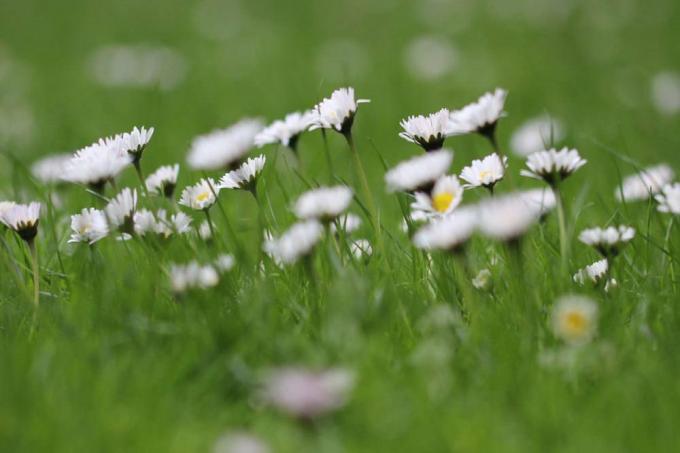
Gold lacquer (Erysimum Cheiri)
The gold lacquer is able to captivate from afar with its lush flowers. On closer inspection, it complements its appearance with an intense, sweet scent, which turns a visit to the graves into a special natural event.
- Appearance: short-stalked leaves arranged in a rosette in the lower area, while the upper leaves are dense crowded, also shorter and almost sessile, racemose inflorescence with 10 to 30 stem-plate flowers in yellow, brown or reddish
- Size: 220 to 60 centimeters
- Flowering period: May to June
- Other: strong scent, biennial plant

Plants from R - S
Ranunculus/ Buttercup (Ranunculus)
Ranunculus is known from numerous gardens. A similarly large variety of colors as the tulip, but a much denser and more lush growth it has become a popular solitary plant that has only a few additional flowers on the grave needed.
- Appearance: three- to five-part, bird's-foot-like, opposite leaves, one to five flowers end or Laterally on a stalk that clearly protrudes above the foliage leaves, dense, radially symmetrical flowers in numerous numbers Color variations
- Size: 30 to 35 centimeters
- Flowering period: from May
- Other: very large variety, with great differences in color, as well as number and size of flowers
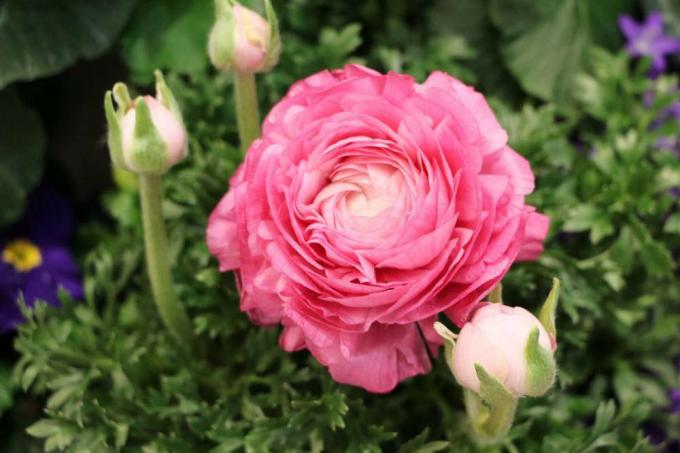
Pansy (viola)
One of the most famous spring plants is the pansy. As both traditional and widespread planting, it creates a reference to tradition and is therefore very suitable for graves and cemeteries.
- Appearance: basal, radial leaves with a pointed to oval shape and a clear central vein, numerous three- to four-petalled flowers with a very flat, wide open flower shape, colors from white to yellow, orange, red and blue to purple, mostly dark to black center
- Size: up to 20 centimeters
- Flowering time: from April
- Other: also known as the eye of Christ, often im autumn again blooming, when raised from seed only blooms in the second year

Note: The well-known horned violet is a type of pansy and therefore logically belongs to the violets as well. In terms of appearance and flowering time, it is very close to the pansy, so that it is not considered separately at this point.
Plants with V
Forget-Me-Not (Myosotis)
The name of this decorative, but at the same time discreetly restrained plant creates a direct reference to the grave planting. Handed down from the Middle Ages as a plea to God not to be forgotten, the meaning of the name can be transferred directly to the person buried in the grave. In this way, decorative planting can be harmoniously combined with symbolic meaning.
- Appearance: entire, mostly hairy, indigenous foliage leaves, small light blue flowers mostly paired on thin stems that clearly protrude above the leaves, 5 petals per flower
- Size: up to 30 centimeters
- Flowering period: April to June
- Other: mostly bushy to flat growing, herbaceous plant, annual or perennial possible


